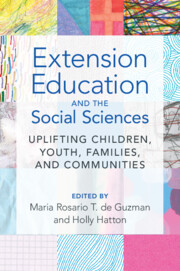Book contents
- Extension Education and the Social Sciences
- Extension Education and the Social Sciences
- Copyright page
- Contents
- Contributors
- Part I Overview of Extension and the Social Sciences
- Part II Addressing Key Issues in the Well-Being of Children, Youth, and Families
- Part III Looking Ahead: Emerging Issues and Trends
- Chapter 10 Cooperative Extension and Diversity
- Chapter 11 Reaching and Serving Underrepresented Families
- Chapter 12 Preparing the Next Generation of Extension Professionals
- Chapter 13 Extending Extension’s Outreach and Engagement with Social Media
- Index
- References
Chapter 13 - Extending Extension’s Outreach and Engagement with Social Media
A Case Study with an Integrated Media Campaign
from Part III - Looking Ahead: Emerging Issues and Trends
Published online by Cambridge University Press: 28 March 2024
- Extension Education and the Social Sciences
- Extension Education and the Social Sciences
- Copyright page
- Contents
- Contributors
- Part I Overview of Extension and the Social Sciences
- Part II Addressing Key Issues in the Well-Being of Children, Youth, and Families
- Part III Looking Ahead: Emerging Issues and Trends
- Chapter 10 Cooperative Extension and Diversity
- Chapter 11 Reaching and Serving Underrepresented Families
- Chapter 12 Preparing the Next Generation of Extension Professionals
- Chapter 13 Extending Extension’s Outreach and Engagement with Social Media
- Index
- References
Summary
Extension’s charge has long been to extend research, information, and innovative strategies and programs from Land Grant University and research centers. Extension is working in an era of digital communication where social media is evidencing extraordinary growth. Most adults in the United States now report accessing information from social media platforms. As such the use of social media and technology in Extension is rapidly becoming a necessity. As Extension has served as a trusted source of information for over a century, it is currently facing a time of transition to explore how to effectively use technology to reach audiences. This chapter explores current trends in digital communication and highlights the ways that Extension can create and deliver information using social media. We propose intentionality in strategies and factors to consider when engaging via social media. Finally, we pose questions regarding Extension’s continued relevance and possibly changing role in considering the rapidly shifting information landscape.
- Type
- Chapter
- Information
- Extension Education and the Social SciencesUplifting Children, Youth, Families, and Communities, pp. 267 - 285Publisher: Cambridge University PressPrint publication year: 2024



